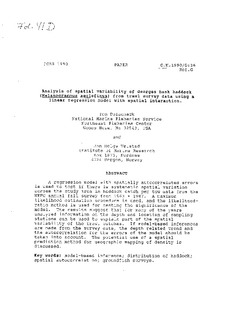| dc.contributor.author | Polacheck, Tom | |
| dc.contributor.author | Vølstad, Jon Helge | |
| dc.date.accessioned | 2012-08-21T14:32:19Z | |
| dc.date.available | 2012-08-21T14:32:19Z | |
| dc.date.issued | 1990 | |
| dc.identifier.citation | This report is not to be cited without prior reference to the authors | no_NO |
| dc.identifier.uri | http://hdl.handle.net/11250/104729 | |
| dc.description.abstract | A regression model with spatially autocorrelated errors
is used to test if there is systematic spatial variation
across the study area in haddock catch per tow data from the
NEFC annual fall survey from 1963 - 1987. A maximum
likelihood estimation procedure is used, and the likelihoodratio
method is used for testing the significance of the
model. The results suggest that for many of the years
analyzed information on the depth and location of sampling
stations can be used to explain part of the spatial
variability of the trawl catches. If model-based inferences
are made from the survey data, the depth related trend and
the autocorrelation for the errors of the model should be
taken into account. The potential use of a spatial
prediction method for geographic mapping of density is
discussed. | no_NO |
| dc.language.iso | eng | no_NO |
| dc.publisher | ICES | no_NO |
| dc.relation.ispartofseries | ICES CM Documents;1990/D:36 | |
| dc.subject | demersal fish | no_NO |
| dc.subject | bunnfisk | no_NO |
| dc.subject | distribution | no_NO |
| dc.subject | utbredelse | no_NO |
| dc.subject | acoustics | no_NO |
| dc.subject | akustikk | no_NO |
| dc.title | Analysis of spatial variability of Georges Bank haddock (Melanogrammus aeglefinus) from trawl survey data using a linear regression model with spatial interaction | no_NO |
| dc.type | Working paper | no_NO |
| dc.subject.nsi | VDP::Mathematics and natural science: 400::Geosciences: 450::Oceanography: 452 | no_NO |
| dc.subject.nsi | VDP::Mathematics and natural science: 400::Information and communication science: 420::Mathematical modeling and numerical methods: 427 | no_NO |
| dc.source.pagenumber | 17 s. | no_NO |
